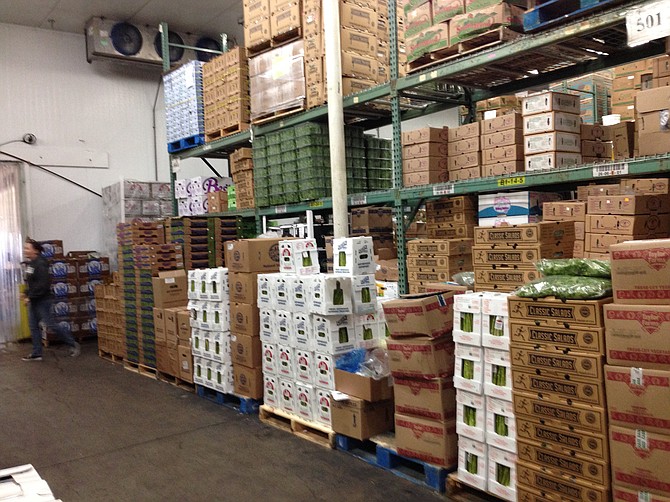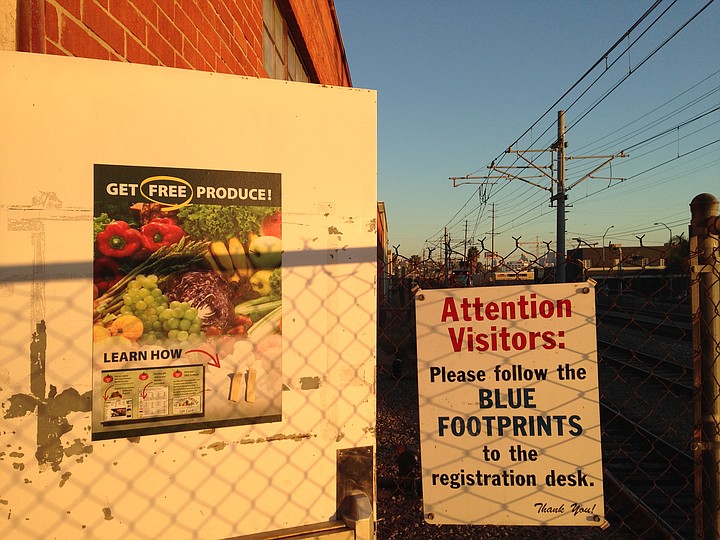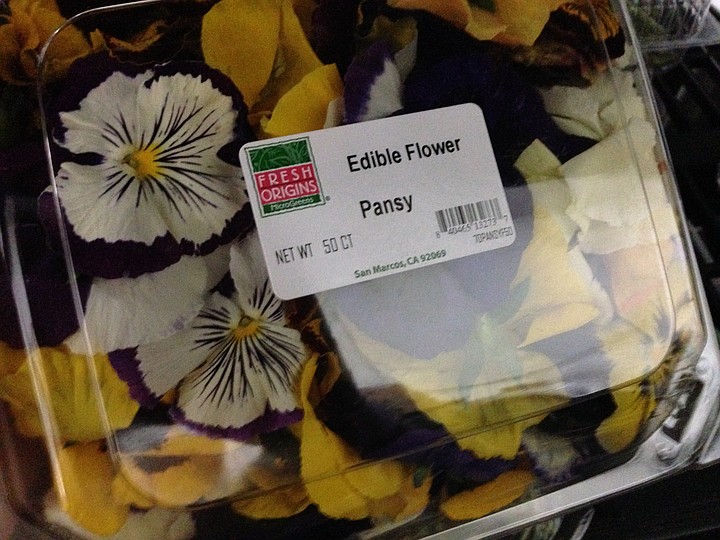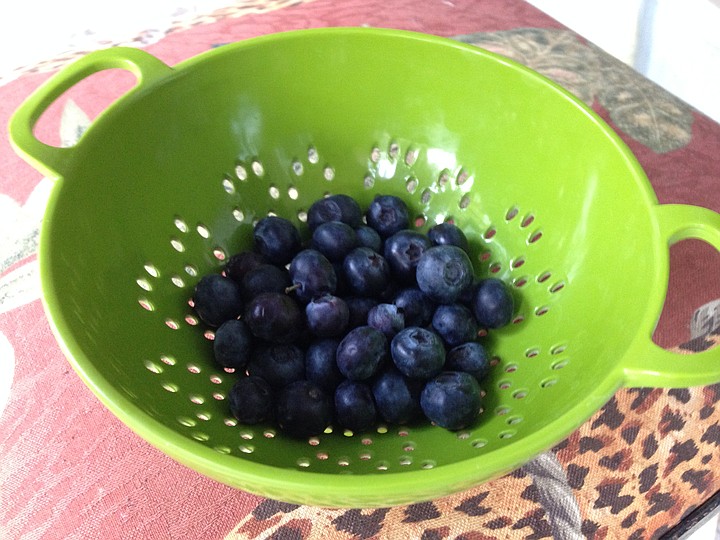 Facebook
Facebook
 X
X
 Instagram
Instagram
 TikTok
TikTok
 Youtube
Youtube


I dine out a lot, and often wonder where the restaurants I visit find their ingredients. For example, where would a chef who's into molecular gastronomy pick up an emulsifying agent like soy lecithin to make culinary foam? Or, where does one find quail eggs? Or even microgreens?
Questions like these led me to Specialty Produce, wholesale distributor for many of San Diego's restaurants — if you're reading this you've definitely eaten at several of them. Located in that little industrial strip where Point Loma becomes Mission Hills, the busy warehouse receives and distributes ingredients daily. And during the day, it's open to the public.
Strictly speaking, this is not a grocery store. You realize this when you find the entrance, behind a loading dock, through a heavy metal door where trains whiz by only a few feet away on the other side of a chain link fence. From there you follow a yellow path painted on the concrete, guiding you into a warehouse, where you register as a customer and sign waivers recognizing the risk of walking through an active warehouse, where pushcarts and forklifts are constantly at work while the staff fills orders. You agree to don the provided plastic gloves before you handle any produce.

Boxes of it are stacked high in the middle of the floor, while tall industrial shelving forms short aisles against one wall. There you'll find enormous cans of ingredients ranging from beans to tomato sauce, as well as bulk bins of grains and flours. Along another wall you'll find gourmet ingredients including canned escargot or pistachio oil, situated among your choice of sea salts.
Through thick plastic strip doors in the back you'll find the cooled produce section — more boxes stacked every which way, filled with fruit, vegetables, dairy, and various sizes of bok choy. Being close to Valentine's Day, I found what I assume was an unusually large assortment of edible flowers.
To the left of that room, another cooled environment contains all organic produce. This may have been the best organized area, the foodie equivalent of a gold mine, with heirloom vegetables, juicy looking berries, and some stunning examples of lesser known options. Lime radishes, anyone?

There was no shortage of reasons to shop here, despite the complicated browsing, and the fact that variable pricing for local restaurants means zero pricing on the shelves. You just have to pick something out and hope you can afford it. And that it'd be worth it when you rang it up at the cash register.
I picked out some blueberries to get an idea how good this produce could be. I eat blueberries all the time, and however big, brightly colored and juicy they look, there's at least one or two berries in the bunch that literally taste like paint. I put myself in the mind of a restaurateur. If I'm serving food to a demanding public, can I afford to serve a paint-tasting berry? Wouldn't I insist on sourcing consistently high quality, great tasting ingredients?

I went conventional, picking up a 6 ounce pack of berries that turned out to cost a reasonable $3.85. I passed on the local, organic option, because I know I could get those at a farmer's market (for less than the $6.20 they cost here). The berries I took home were a product of Chile, of course. (I can't help wonder if Chileans see an influx of California grown produce during their winter months).
They were fantastic. All sweet, all juicy, and not a hint of paint. Did I get lucky? Hopefully, local restaurant owners don't count on luck. I doubt I can make a habit of perusing this chaotic space for my weekly grocery needs, but I will be back, especially when I'm looking to impress somebody with some delicious and potentially exotic home cooking.



I dine out a lot, and often wonder where the restaurants I visit find their ingredients. For example, where would a chef who's into molecular gastronomy pick up an emulsifying agent like soy lecithin to make culinary foam? Or, where does one find quail eggs? Or even microgreens?
Questions like these led me to Specialty Produce, wholesale distributor for many of San Diego's restaurants — if you're reading this you've definitely eaten at several of them. Located in that little industrial strip where Point Loma becomes Mission Hills, the busy warehouse receives and distributes ingredients daily. And during the day, it's open to the public.
Strictly speaking, this is not a grocery store. You realize this when you find the entrance, behind a loading dock, through a heavy metal door where trains whiz by only a few feet away on the other side of a chain link fence. From there you follow a yellow path painted on the concrete, guiding you into a warehouse, where you register as a customer and sign waivers recognizing the risk of walking through an active warehouse, where pushcarts and forklifts are constantly at work while the staff fills orders. You agree to don the provided plastic gloves before you handle any produce.

Boxes of it are stacked high in the middle of the floor, while tall industrial shelving forms short aisles against one wall. There you'll find enormous cans of ingredients ranging from beans to tomato sauce, as well as bulk bins of grains and flours. Along another wall you'll find gourmet ingredients including canned escargot or pistachio oil, situated among your choice of sea salts.
Through thick plastic strip doors in the back you'll find the cooled produce section — more boxes stacked every which way, filled with fruit, vegetables, dairy, and various sizes of bok choy. Being close to Valentine's Day, I found what I assume was an unusually large assortment of edible flowers.
To the left of that room, another cooled environment contains all organic produce. This may have been the best organized area, the foodie equivalent of a gold mine, with heirloom vegetables, juicy looking berries, and some stunning examples of lesser known options. Lime radishes, anyone?

There was no shortage of reasons to shop here, despite the complicated browsing, and the fact that variable pricing for local restaurants means zero pricing on the shelves. You just have to pick something out and hope you can afford it. And that it'd be worth it when you rang it up at the cash register.
I picked out some blueberries to get an idea how good this produce could be. I eat blueberries all the time, and however big, brightly colored and juicy they look, there's at least one or two berries in the bunch that literally taste like paint. I put myself in the mind of a restaurateur. If I'm serving food to a demanding public, can I afford to serve a paint-tasting berry? Wouldn't I insist on sourcing consistently high quality, great tasting ingredients?

I went conventional, picking up a 6 ounce pack of berries that turned out to cost a reasonable $3.85. I passed on the local, organic option, because I know I could get those at a farmer's market (for less than the $6.20 they cost here). The berries I took home were a product of Chile, of course. (I can't help wonder if Chileans see an influx of California grown produce during their winter months).
They were fantastic. All sweet, all juicy, and not a hint of paint. Did I get lucky? Hopefully, local restaurant owners don't count on luck. I doubt I can make a habit of perusing this chaotic space for my weekly grocery needs, but I will be back, especially when I'm looking to impress somebody with some delicious and potentially exotic home cooking.
Comments